OSINT Trends for 2023 and Beyond
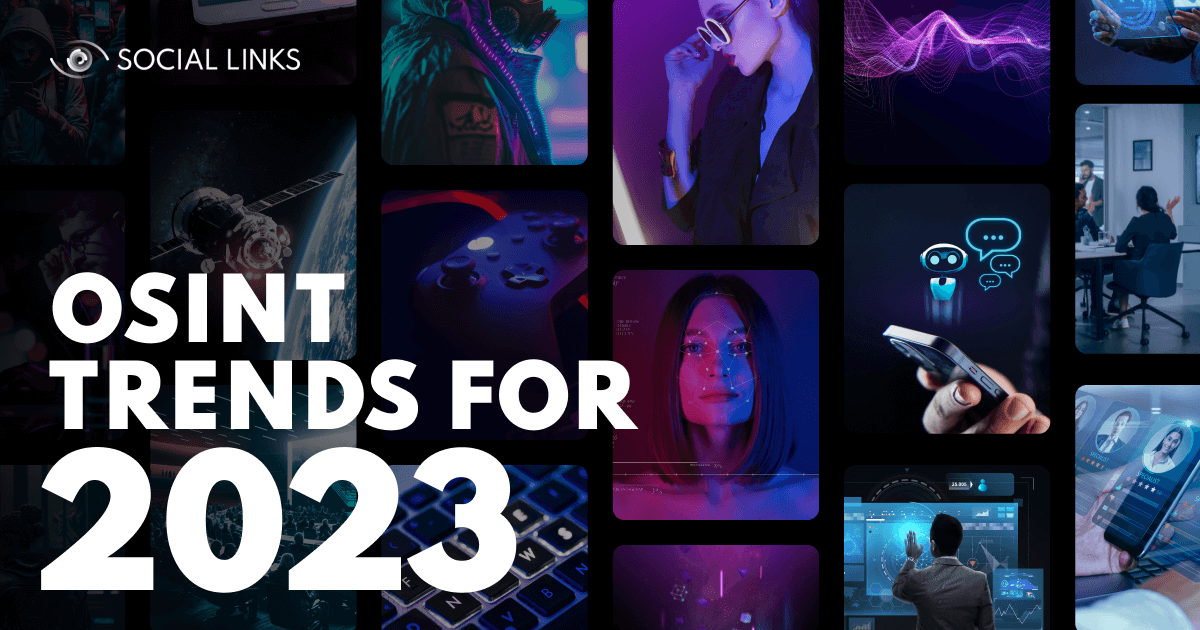

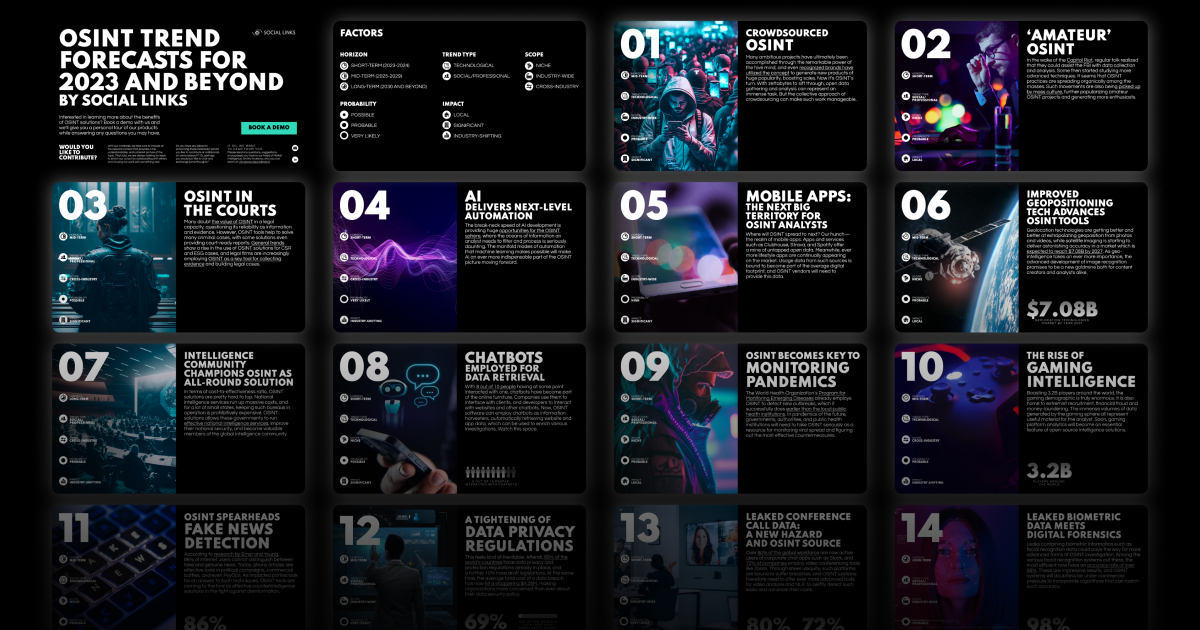
With a CAGR projected to reach 17.9% by 2028, the OSINT market size is all set for a serious upgrade. This raises a tantalizing question: as the market expands, what OSINT trends can we expect in 2023 and later? Being developers of open-source intelligence solutions, this question is of course hugely important for Social Links. But it also has a broader technological and social relevance.
So, in this article, we’re taking an in-depth look at what form these new developments may take, how likely they are, and what implications they could have for the OSINT industry and beyond. With projections for both the short and long term, we cast our gaze into the future to see what may be glimmering on the open-source intelligence horizon.
We’ve come up with 18 in total. And to help readers navigate the main aspects of each trend, we’ve put together a key of indicators shown for each forecast. These are based on the following 5 factors:

Crowdsourcing is one of those social innovations that the internet has been instrumental in bringing about. Many ambitious projects have ultimately been accomplished through the remarkable power of the hive mind, while even recognized brands have utilized the concept to generate new products of huge popularity, boosting sales.
Now it’s OSINT’s turn. With zettabytes to sift through, open data gathering and analysis can represent an immense task. But the collective ethos of crowdsourcing can make such work manageable, allowing cases to be solved that the police couldn’t get to the bottom of with all their resources. Trace Labs is a good example of an organization that can make this happen, not to mention Bellingcat and their groundbreaking investigations.
Crowdsourcing is also driving progress for GEOINT (Geospatial Intelligence) and IMINT (Imagery Intelligence), which use collective knowledge to gain insights from low-res satellite photos or maps and other publicly available imagery. For example, institutional communities like GeoHIVE leverage crowdsourced human output to identify and validate image data. This form of intelligence is undoubtedly on the rise and will become a useful alternative to high-end solutions.

In the wake of the Capitol Riot happenings, regular folk realized that they could assist the FBI with information collection and simple data analysis. Progressing this, many people started studying more advanced OSINT techniques: Reddit users began creating amateur investigation threads, and so-called ‘anti-bullies’ started tracing cyber bullies and reporting them.
It seems that open-source intelligent practices are spreading organically among the masses rather than remaining in some exclusive, highly-specialized field. And this is an OSINT trend that we expect to gain momentum in 2023. Such movements are also being picked up by mass culture, further popularizing amateur OSINT projects and generating more enthusiasts.
Whether these movements are an unmixed good remains to be seen. While the public adoption of such techniques may help to weed out wrongdoers in some cases, it could easily light the way to all kinds of privacy intrusion, arming stalkers and suchlike. Amateur OSINT will probably span the ethical spectrum like other technologies.

While it has enjoyed a broad impact, many researchers doubt the value of OSINT in a legal capacity, questioning its reliability as a source of information and validity as evidence. Despite the skepticism, open-source intelligence solutions are instrumental in solving various criminal cases, with some systems even providing court-ready reports.
General trends show a rising popularity in the use of OSINT tools for investigating CSR (Corporate Social Responsibility) and ESG (Environmental, Social, and Governance) non-compliance. At the same time, agencies and law firms are increasingly employing OSINT as a key tool for collecting evidence and building legal cases.

Neural networks that work on AI algorithms are already revolutionizing the tech landscape and professional life. One moment we have the efficiency of Midjourney’s image construction shocking hundreds of thousands of designers, the next ChatGPT erupts onto the scene with the potential to turn many a business process upside down. Now, there is even talk of using ChatGPT for generating malicious code.
The break-neck speed of AI development is providing huge opportunities for the open-source intelligence sphere, where the oceans of information an analyst needs to filter and the process is seriously daunting. The manifold modes of automation that machine learning makes possible will make AI an ever more indispensable part of the OSINT picture moving forward.

The history of OSINT charts its development from a little-known reconnaissance method focused on physically published or publicly broadcast material. The explosion of open data in the advent of the internet gave a new meaning to open-source intelligence, as it absorbed the online domain and became an essential multi-industry discipline.
Social media platforms like Facebook, Twitter, Instagram, and—more recently—TikTok have become open data staples for the OSINT analyst. So, the question is: where will the discipline look next for new and untapped open data pastures? Our hunch—the realm of mobile apps.
Apps and services such as Clubhouse, Strava, and Spotify already have the potential to provide OSINT analysts with valuable information. At the same time, we see a continual flow of new lifestyle apps appearing on the market. This is seriously fertile ground, and if the value of this data is realized, mobile apps will become standard fixtures of the average digital footprint. Consequently, OSINT vendors will need to provide this data.
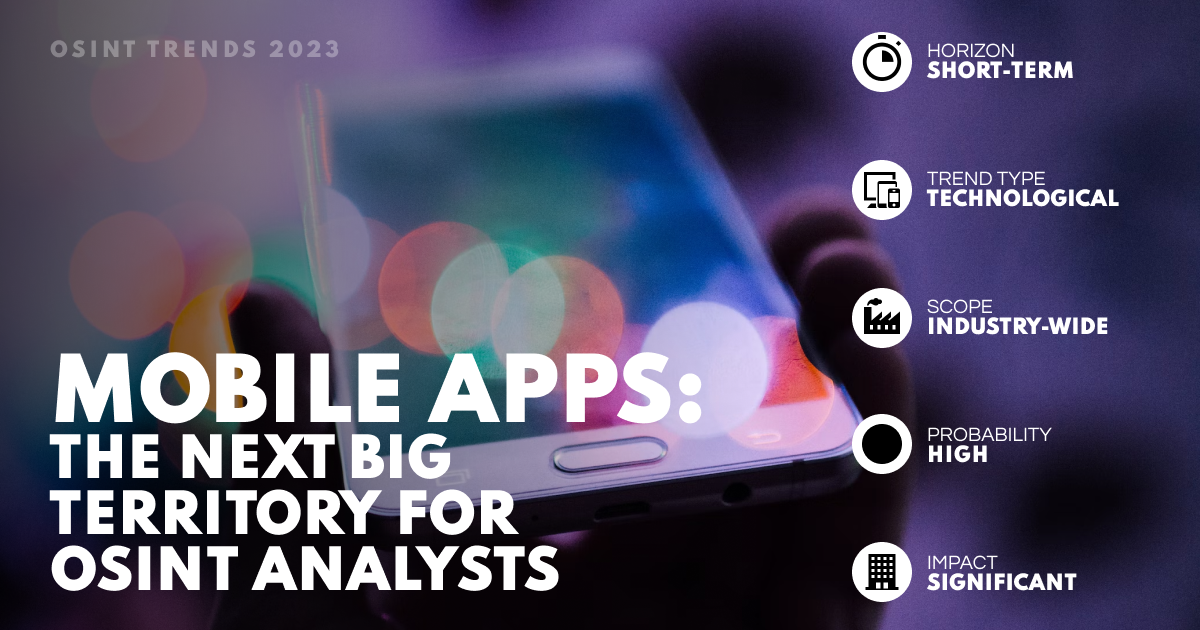
Geolocation technologies are getting better and better at extrapolating geoposition from a photo or a video, without the need to manually identify the location. As geo-intelligence takes on ever more importance, the advanced development of image recognition promises to be a new goldmine both for content creators and analysts alike.
Meanwhile, satellite imaging is starting to deliver astonishing accuracy in parallel with huge market expansion. The commercial satellite imaging market is currently valued at $4.15B and is expected to reach $7.08B by 2027. This remarkable success is largely thanks to the fact that modern satellite imagery, including multispectral captions, can be used in many different spheres such as natural disaster detection and management, urban planning and construction, agriculture, archeology, and intelligence.
High-resolution satellite imagery can offer the investigator a wide range of insightful data. However, high-res geodata is excessively steep for most everyday investigations, with an average cost of $50 per square kilometer. That said, as the market becomes more competitive and new private satellite constellations are sent into orbit every year, such information will become affordable for routine analytical work.
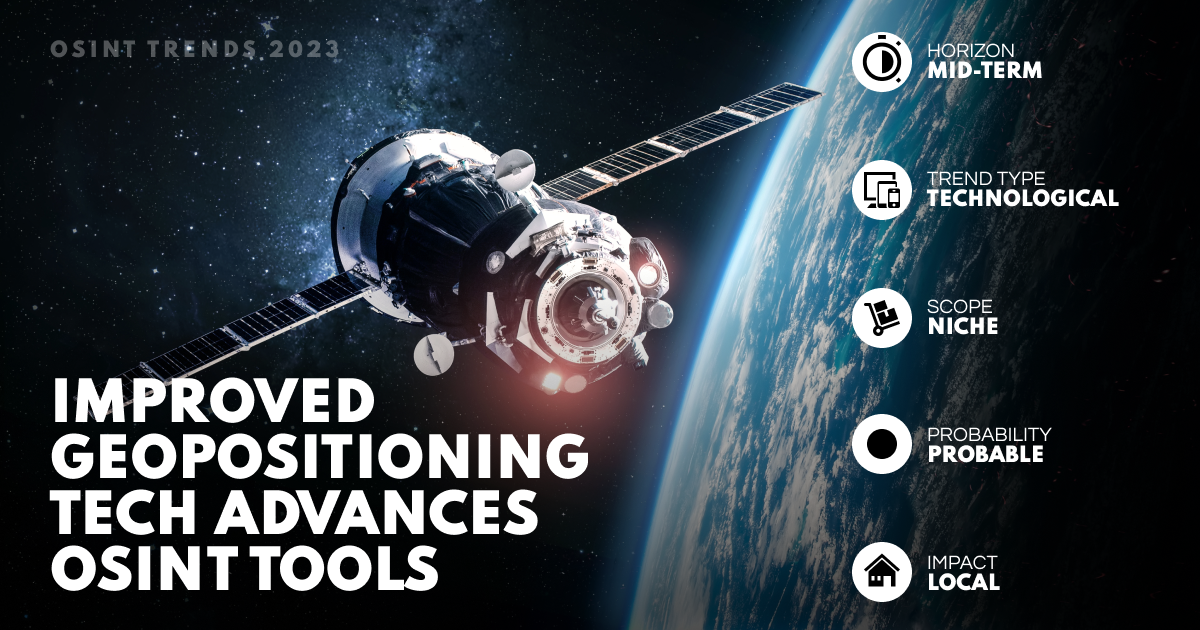
In terms of cost-to-effectiveness ratio, OSINT solutions are pretty hard to top as a force for generating actionable intelligence. Combining that with other attributes such as high levels of safety and an expansive global reach, you can appreciate why OSINT is becoming so popular among the intelligence community—a trend we believe will continue.
It is no secret that national foreign intelligence services run up staggering costs and that, for a lot of small states, keeping such bureaus in operation is prohibitively expensive. OSINT allows these governments to set up and maintain effective national intelligence services, improve their national security, and become valuable members of the global intelligence community.

This OSINT trend could well come into play as early as 2023. With over 300,000 currently active on Meta services alone, and 8 out of 10 people having at some point interacted with one, chatbots have become part of the online furniture. The internet is host to a huge number of these worker programs, and they are being put to various uses.
Commonly employed by companies to interface with clients, chatbots offer companies a cheap and hassle-free alternative to human resources. They often come in handy for developers as well, interacting with websites and other chatbots in a way that is totally separated from human agency. They’re like good little employees that just get on with their work.
This is where they come into the purview of OSINT software. Firstly, chatbots can be employed as information harvesters, automatically retrieving website and application data, which can be used to enrich various investigations. Secondly, chatbots can be designed to conduct automated social engineering for LEAs, when investigators are fishing for information that isn’t out in the open.
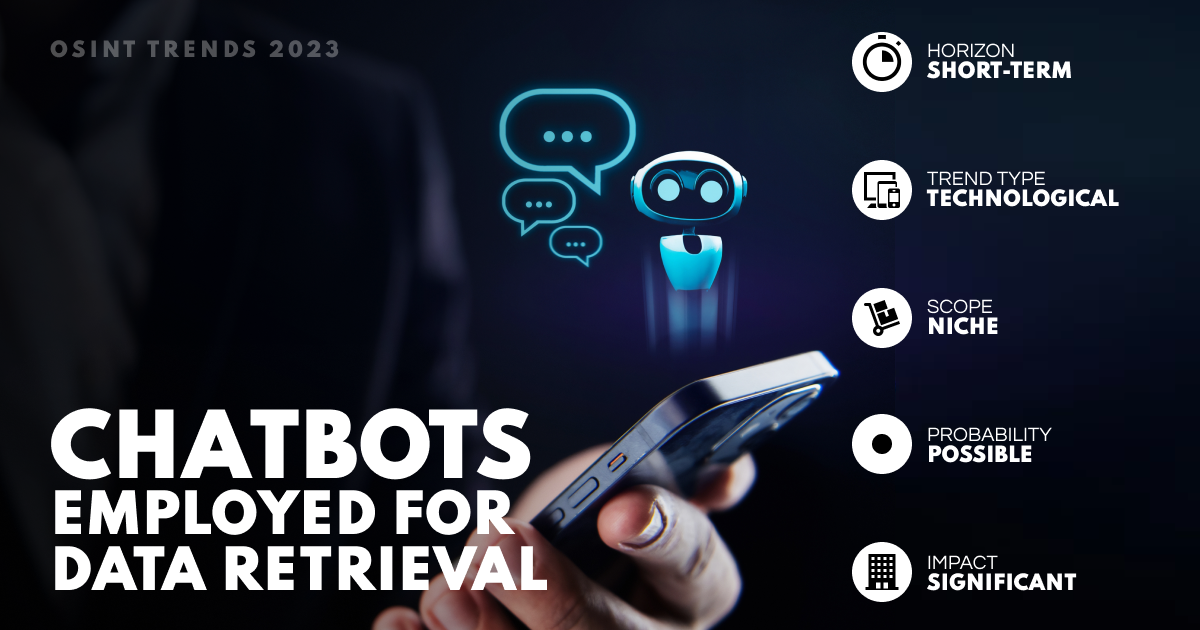
Our continuing battle against COVID has demonstrated the remarkable efficiency of OSINT as a method for detecting outbreaks and mapping the development of pandemics and epidemics. Social media and search engine analyses have empowered researchers with the temporal and geographical data required to track the genesis and evolution of a virus among the populace.
The World Health Organization’s Program for Monitoring Emerging Diseases already employs OSINT to detect new outbreaks, which it successfully does earlier than the local public health institutions. Open data has also been harnessed to determine COVID dynamics in China and Indonesia, and could do the same with Ebola or HIV, for instance.
In pandemic or epidemic outbreaks of the future, governments, authorities, and public health institutions will need to take OSINT seriously as a resource for monitoring viral spread, and figuring out the most effective countermeasures.
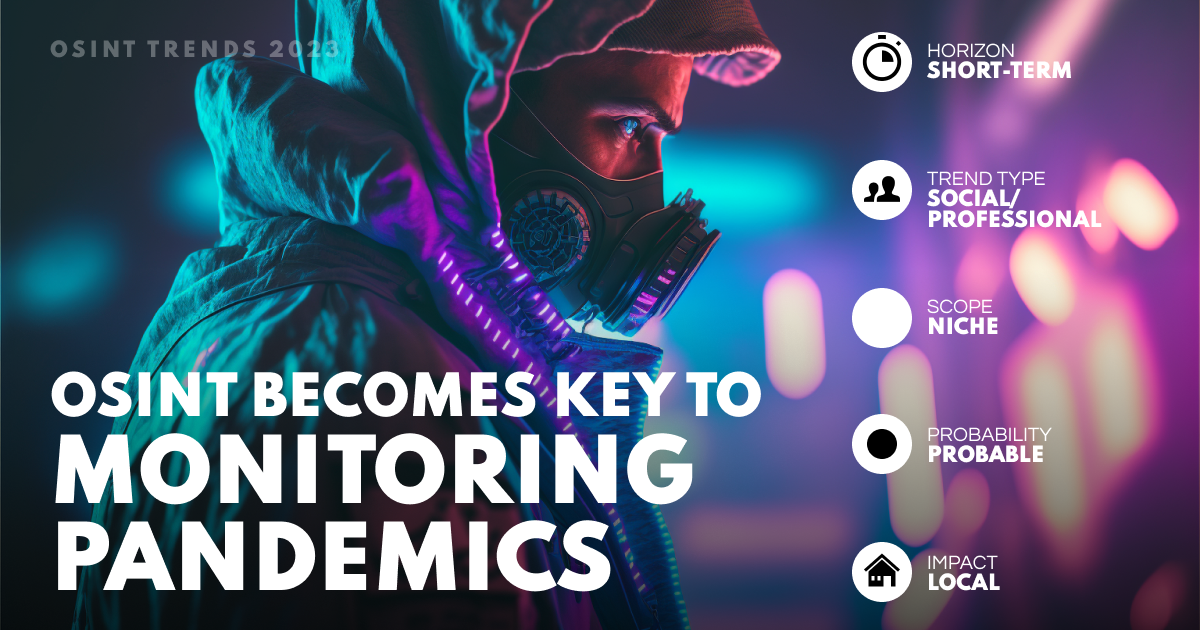
Boasting 3.2B players around the world, the gaming demographic is truly enormous and represents the largest entertainment industry on earth. Studies show that 81% of gen-z folk and 77% of millennials consider themselves to be gamers. Meanwhile, more than 140M people actively use the game video streaming platform Twitch, while Discord has now exceeded 300M registered users.
Unfortunately, this sphere is not immune to criminality, and gaming platforms have demonstrated an increase in illicit activities alongside the usership growth. Extremist recruitment, financial fraud and money-laundering can, and do, take place on these online domains, and are becoming an issue that is difficult to ignore.
As can be easily imagined, the volume of data generated by the gaming sphere is absolutely massive. But this all represents useful material for the OSINT analyst. Soon, gaming platform analytics will become an essential feature of open-source intelligence solutions.
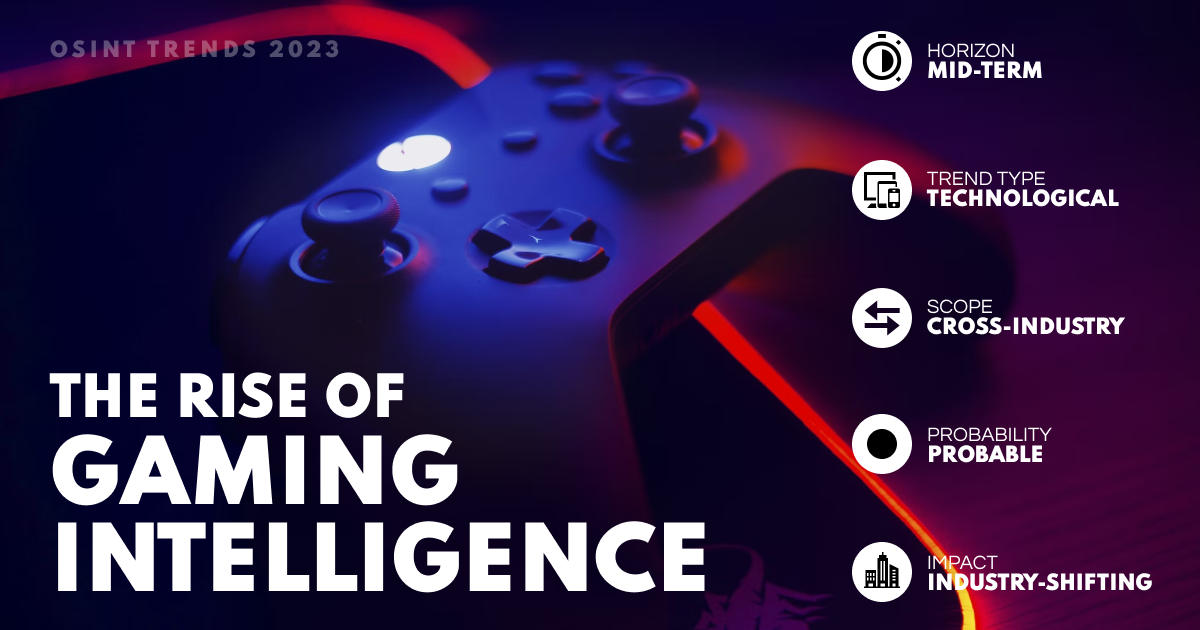
Our casually passive modes of media consumption combined with susceptibility to confirmation bias have fuelled a huge rise in fake news and misinformation. According to research by Ernst and Young, 86% of internet users cannot distinguish between fake and genuine news, while phony stories are 70% more likely to be retweeted than true ones.
Today, fake news is proving an effective tool in political campaigns, competitive commercial battles, and even military PsyOps (Psychological Operations). As impacted parties look for an answer to these underhand techniques, OSINT tools are coming to the fore as effective counterintelligence solutions in the fight against disinformation.
As things stand now, OSINT analysts have to manually check the fakes to zero in on their origin. However, in the long run social media and news agencies may implement automated OSINT solutions to filter out the fakes.
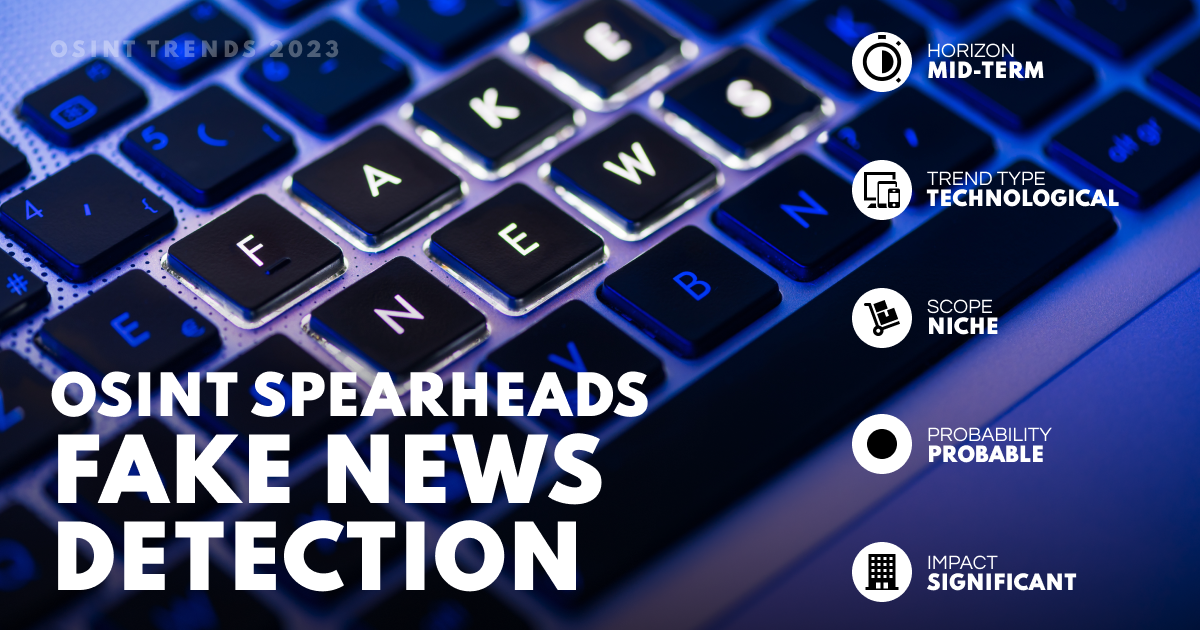
This feels kind of inevitable. Afterall, as data proliferates while becoming further commoditized, and leak after leak demonstrates the fallibility of almost all cyber security systems, it stands to reason that policy would form part of the response. And this is demonstrably the case. Currently, 69% of the world’s countries have implemented data privacy and protection regulations, and a further 10% have draft legislations in place.
At the same time, the spiraling issue of cyber security is an elephant in the room. The average total cost of a data breach has now hit a staggering $4.35M, making organizations more concerned than ever about their data security policy. Unsurprisingly, penalties for policy infringements by data handlers are becoming increasingly severe. To date, the biggest fine for GDPR violation came to $877M and was levied against Amazon.
These countermeasures could ultimately have ramifications for the OSINT sphere. For example, if new legislation is drafted restricting the third-party analysis of open data, open-source intelligence teams will have to tread more carefully. As it stands though, there is little indication that the policy will become that draconian.

This is an OSINT trend that may kick off as early as 2023. While we tend to associate leaks with login passwords and bank details, they can be far broader than that. And a type of content that looks set to become a more common component of such data spills is information from corporate collaboration tools and video conferencing systems.
Due to the huge rise in remote working that accompanied the COVID pandemic, over 80% of the global workforce are now active users of corporate chat apps such as Slack, Microsoft Teams, etc. On top of this, 72% of companies employ video conferencing tools like Zoom for both internal and external communication.
Through their sheer ubiquity, such platforms are bound to suffer breaches which could compromise the data of countless organizations. OSINT system vendors therefore need to be developing ever more advanced tools for video analysis and natural language processing, to swiftly detect such leaks and minimize their costs.

Leaks containing biometric information such as facial recognition data could pave the way for more advanced forms of OSINT investigation. Since the iPhone X was released, people have become increasingly accustomed to facial recognition operations being performed for various aspects of their routine life. Meanwhile, the 500 million surveillance cameras all over the world often allow police investigators to find suspects and missing people.
Among the various facial recognition systems out there, the most efficient now have an accuracy rate of over 98%. These are impressive results, and OSINT systems will doubtless be under commercial pressure to incorporate algorithms that can match such accuracy. Putting such possibilities at the fingertips of OSINT specialists seems like a promising combination for the authorities.
However, as is often the case with surveillance technology, there is a flipside to consider. The same systems that can be used to keep citizens safe, can also be exploited to exercise excessive control over a population. According to WIRED, the Iranian government is implementing facial recognition techniques to detect women breaking disputable hijab laws.
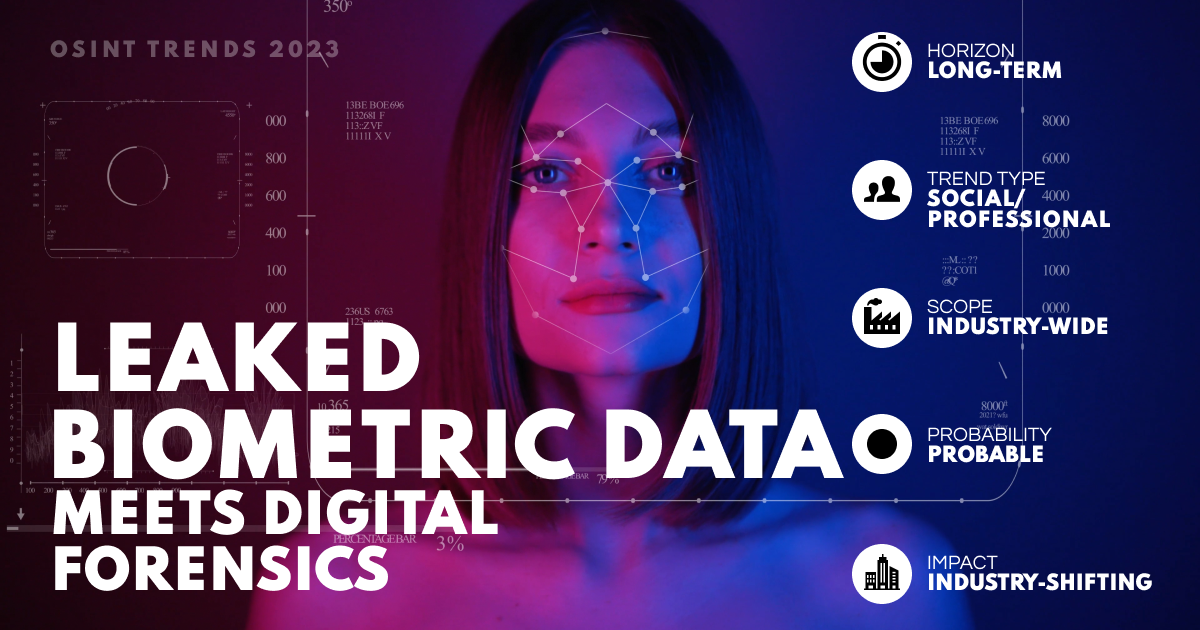
With many Shodan analogues doubtless in the works, the Internet of Things is fast becoming one of the most formidable security issues in the world today. There are now over 13B connected devices globally, and it’s predicted that this figure will more than double to 29B by the year 2030 and even outnumber non-IoT devices.
This sky-high projection looks increasingly realistic through the fact that investors are wild about IoT—more than 10% of all of the venture funding is IoT-related. Despite this, most IoT devices have extremely sketchy security and are frequent sources of data leaks.
The ballooning global data vulnerability issue has clear implications for the OSINT sphere. With data compromises becoming a perpetual issue, the relevance of the discipline will expand, helping organizations promptly identify breaches to minimize the attendant losses, as well as aiding investigators through a wider palette of data to work with.
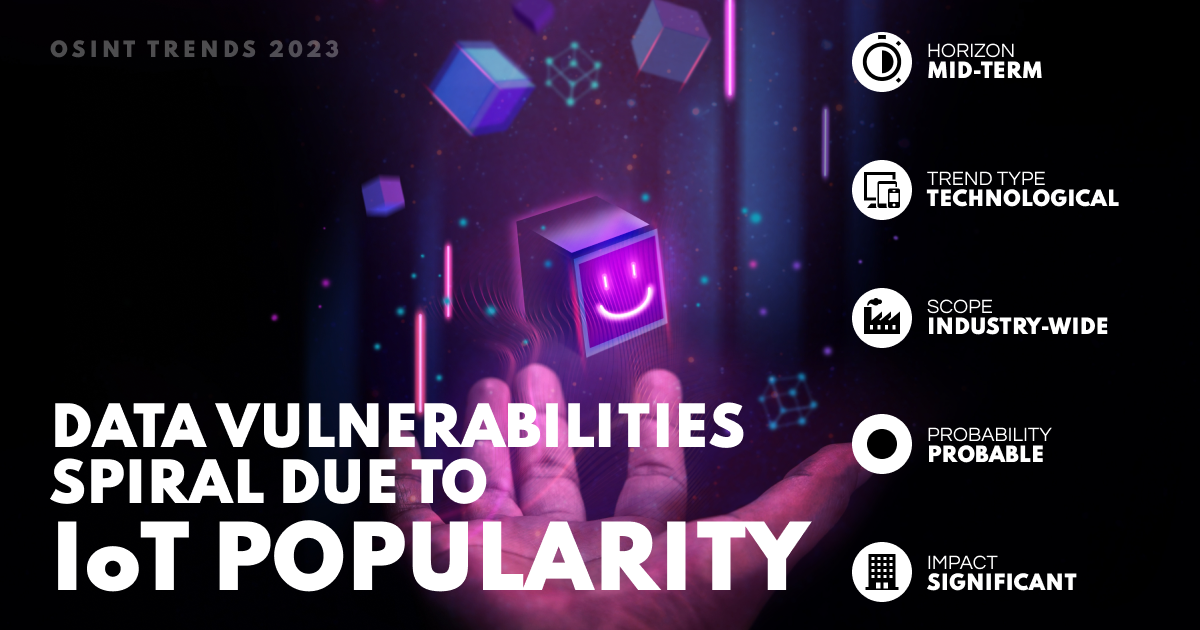
This has been on the cards for quite some time, and progress has arguably been expensively slow. But these costs have really been felt by companies and other organizations, leading to a tightening of policies that don’t just consider technical fixes, but solutions based on a cultural shift.
With nearly 85% of data breaches coming about through human error, corporate security teams have begun raising cognizance of social engineering tactics among the organization’s personnel. While most companies do already indicate higher levels of cyber security awareness, these are still a far cry from representing truly effective safeguards.
But with profit margins and capital at stake, there is a real incentive for awareness to spread. And this will come hand-in-hand with an increased demand for OSINT tools, which can help identify those who are most in need of cybersecurity training.
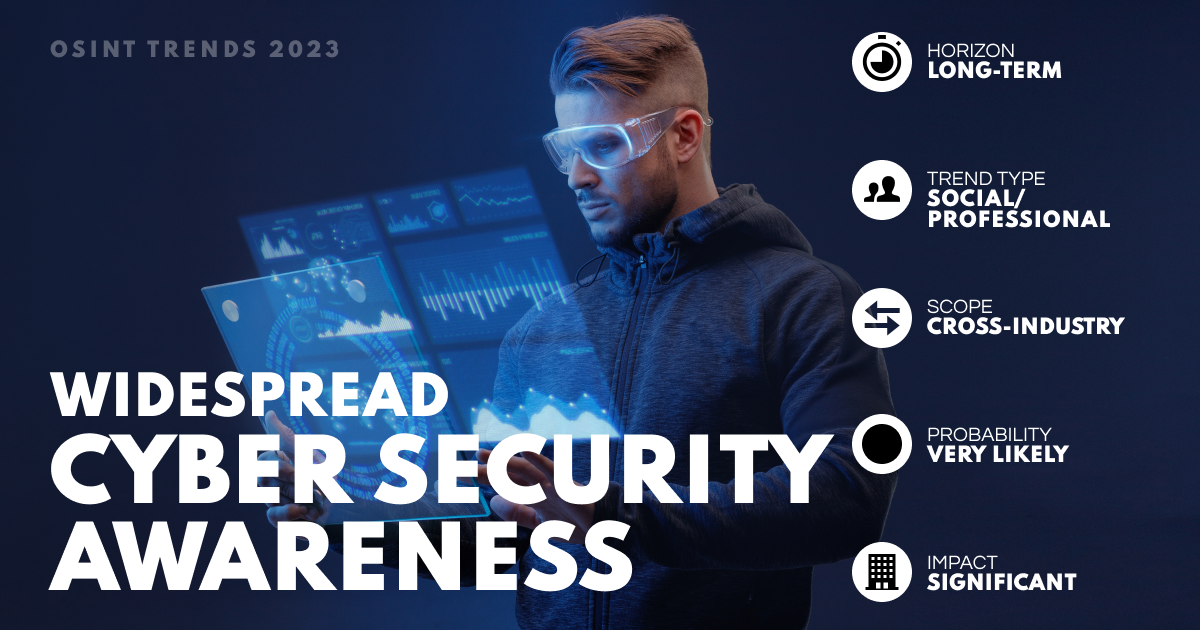
As far as security professionals go, OSINT analysts are among the most highly valued, and yet they are also some of the least common. The reason for this apparent paradox is the old supply and demand issue. There simply aren’t enough to go around. So, they are sought after, and don’t come cheap. The average base salary for a US-based OSINT analyst is now around the $125k mark.
Needless to say, only a minority of organizations can afford such high-paid security professionals, even if they recognize the huge value they will add to their corporate security. The natural solution to this is outsourcing. So, we may well start to see platforms where organizations can reach out to OSINT professionals for specific projects. OSINT-for-hire will be an ideal option for those who can’t run to in-house specialists.

The fashion segment is growing fast and represents the vast commercial business. With a CAGR of 9.14%, the industry is projected to reach over $1T in 2023, and $1.5T by 2027. The companies competing on this market rely heavily on consumer sentiment and trend analysis, which mainly consists of expert opinion provided by boutique research agencies.
However, it seems logical to suppose that OSINT, with its public sentiment analysis methods, could well offer game-changing possibilities in this market, especially in the fast fashion segment, which is particularly transient and fundamentally based on of-the-moment consumer preference.

And that wraps up our OSINT forecasts from where we stand today. We hope these observations and predictions have given you some food for thought.